Our extensive marine datasets have been compiled over the years through several programmes including INFOMAR and EMODnet.
Shoreline Change
INFOMAR
EMODnet Bathymetry
EMODnet Geology
To access specific datasets, with data download formats and software for viewing the data, click on any relevant links below:
Backscatter
Bathymetry
Sub-bottom
Geology
Lidar
Maps
Seabed Habitats & Substrate
Seabed Samples
Shipwrecks
Survey Coverage and Reports
Shoreline rates show how fast the coast is moving. They show if it is moving out towards the sea or back towards the land.
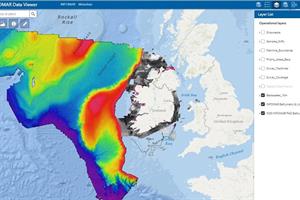 INFOMAR is the INtegrated Mapping FOr the Sustainable Development of Ireland's MArine Resource Programme.
INFOMAR is the INtegrated Mapping FOr the Sustainable Development of Ireland's MArine Resource Programme.
It is a twenty year programme to map Ireland’s seabed. INFOMAR is funded by the Department of the Environment, Cliamte and Communications (DECC), and delivered by joint management partners Geological Survey Ireland and the Marine Institute.
Official website
EMODnet is the European Marine Observation and Data network.
Developing and providing a harmonised Digital Terrain Model (DTM) of the seabed for European sea regions.
Official website
EMODnet is the European Marine Observation and Data network.
Developing and providing a harmonised Digital Terrain Model (DTM) of the seabed for European sea regions.
Official website
 A Multibeam Echosounder (MBES) also measures the strength of the sound returning from the seabed, known as backscatter. Each seabed type (mud, sand, gravel, rock) is given a backscatter value, depending on the strength of the sound returned to the sonar head. Rocky areas have high returns. Soft sediments like sand absorb energy and have low backscatter returns. These values are used to make a grey-scale image with a dark colour for high returns (rocks) and a bright colour for low returns (sand).
A Multibeam Echosounder (MBES) also measures the strength of the sound returning from the seabed, known as backscatter. Each seabed type (mud, sand, gravel, rock) is given a backscatter value, depending on the strength of the sound returned to the sonar head. Rocky areas have high returns. Soft sediments like sand absorb energy and have low backscatter returns. These values are used to make a grey-scale image with a dark colour for high returns (rocks) and a bright colour for low returns (sand).
Backscatter data formats.
Bathymetry (shaded relief, water depth / underwater terrain)
 We use a Multibeam Echosounder (MBES) on a boat to determine water depth. The depth is calculated based on the time it takes the sound to be emitted from the sensor, hit the seabed and bounce back. The water depth maps are known as "Bathymetry Maps". We use software called Fledermaus to get the 3D effect. By using vertical exaggeration, artificial sun-shading (mostly as if there is a light source in the northwest) and colouring the depths using colour maps, it is possible to highlight the subtle relief of the seabed. These are known as "Shaded Relief Bathymetry Maps".
We use a Multibeam Echosounder (MBES) on a boat to determine water depth. The depth is calculated based on the time it takes the sound to be emitted from the sensor, hit the seabed and bounce back. The water depth maps are known as "Bathymetry Maps". We use software called Fledermaus to get the 3D effect. By using vertical exaggeration, artificial sun-shading (mostly as if there is a light source in the northwest) and colouring the depths using colour maps, it is possible to highlight the subtle relief of the seabed. These are known as "Shaded Relief Bathymetry Maps".
Bathymetry data formats.
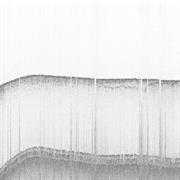
The SBP family includes various types of systems including 'Pinger' systems which transmit a single frequency (~4 kHz) and 'Chirp' systems which transmit a sweep of frequencies (e.g. 2-10 kHz) in a single pulse. These systems use lower sound frequencies that penetrate further into the sediment and examine sediment layers and the extent of bedrock.
Geology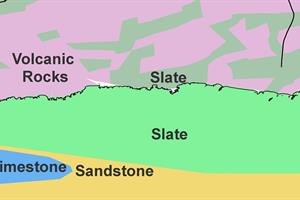 The Onshore Geology map is the Bedrock Geology 1:1 Million scale map. The Seabed geology 1:1 Million scale map was compiled for the EMODnet Geology project (lithology).
The Onshore Geology map is the Bedrock Geology 1:1 Million scale map. The Seabed geology 1:1 Million scale map was compiled for the EMODnet Geology project (lithology).
Geology data formats.
Lidar
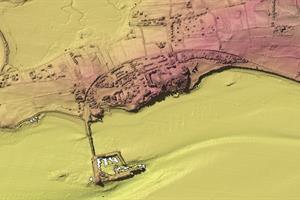 This method of surveying emits two laser light beams from a sensor on-board an airplane. The red beam reaches the water surface and bounces back, while the green beam penetrates the water hits the seabed and bounces back. The difference in time between the two beams returning allows the water depth to be calculated. Digital photographs can also be taken using a downward looking geo-referenced digital camera. We use software called Fledermaus to get the 3D effect. By using vertical exaggeration, artificial sun-shading (mostly as if there is a light source in the northwest) and colouring the depths using colour maps, it is possible to highlight the subtle relief of the seabed/landscape. These are known as "Shaded Relief Lidar Maps".
This method of surveying emits two laser light beams from a sensor on-board an airplane. The red beam reaches the water surface and bounces back, while the green beam penetrates the water hits the seabed and bounces back. The difference in time between the two beams returning allows the water depth to be calculated. Digital photographs can also be taken using a downward looking geo-referenced digital camera. We use software called Fledermaus to get the 3D effect. By using vertical exaggeration, artificial sun-shading (mostly as if there is a light source in the northwest) and colouring the depths using colour maps, it is possible to highlight the subtle relief of the seabed/landscape. These are known as "Shaded Relief Lidar Maps".
Lidar data formats.
MapsMaps available for download
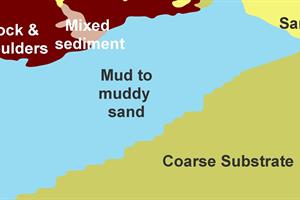 The seabed substrate map is created by grouping seabed areas that are alike. We use the bathymetry, backscatter and seabed samples data to select these areas.
The seabed substrate map is created by grouping seabed areas that are alike. We use the bathymetry, backscatter and seabed samples data to select these areas.
EMODnet Geology WP3 Seabed substrate map. This is a broad scale map (1: 250 000 scale) collected and harmonised by the EMODnet-Geology partners. It is classified using the Folk schema (7 classes).
INFOMAR have produced more detailed Seabed Classification maps for some areas around the Irish coast.
Seabed Habitats data formats.
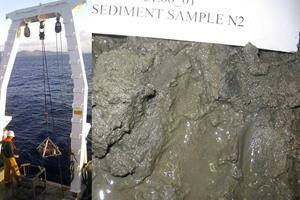 We collect sediment samples from the seabed.
We collect sediment samples from the seabed.
Looking at the samples along with the bathymetry and backscatter maps allows us to group seabed areas of similar nature, and create seabed habitat maps.
Seabed Sample data formats.
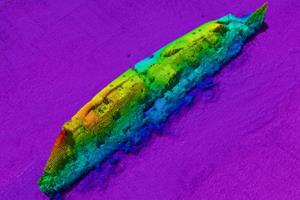 We map shipwrecks.
We map shipwrecks.
Shipwreck data formats.
Download the Survey Coverage polygons & track lines.
You can also download the Survey Leg Reports.